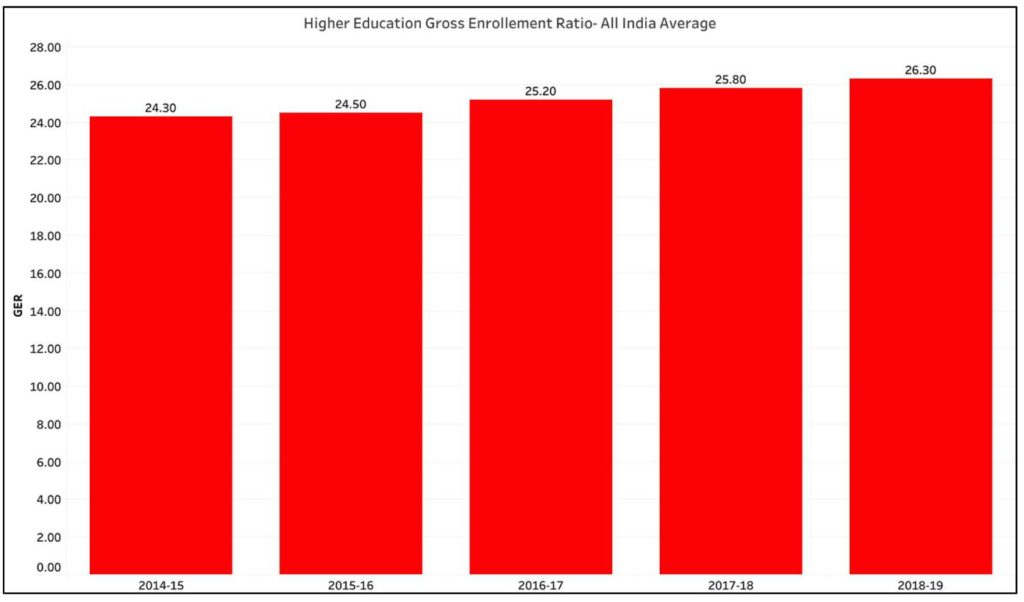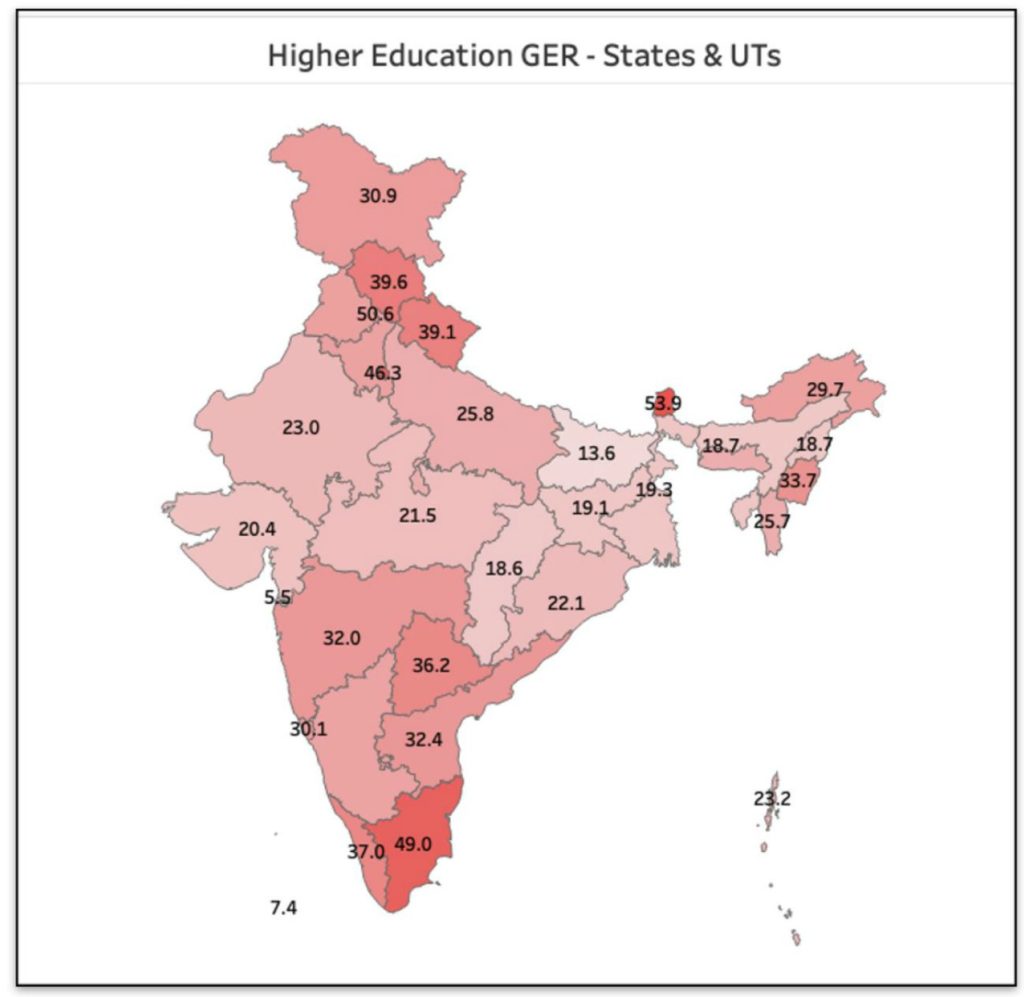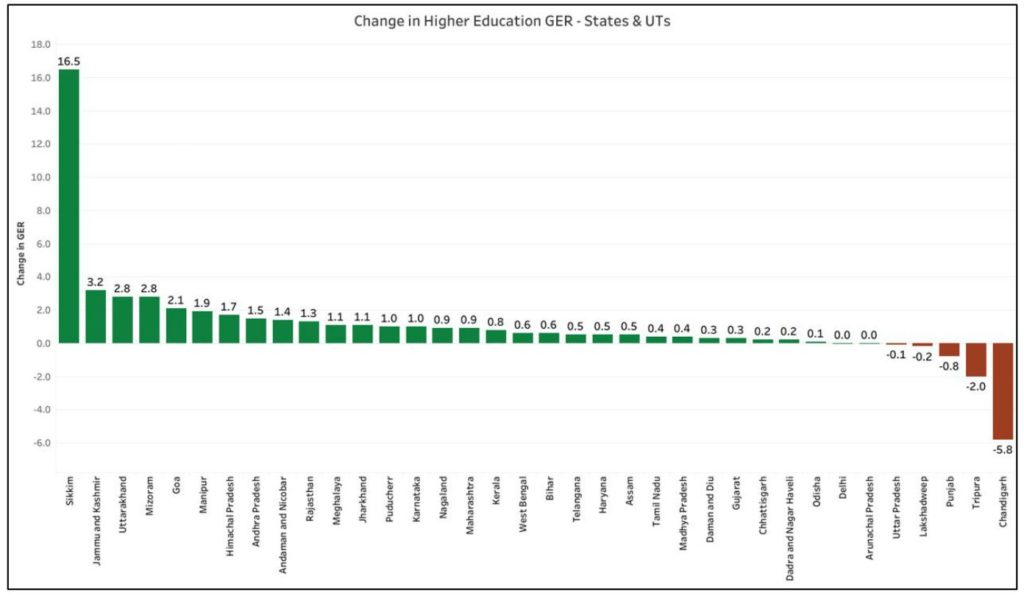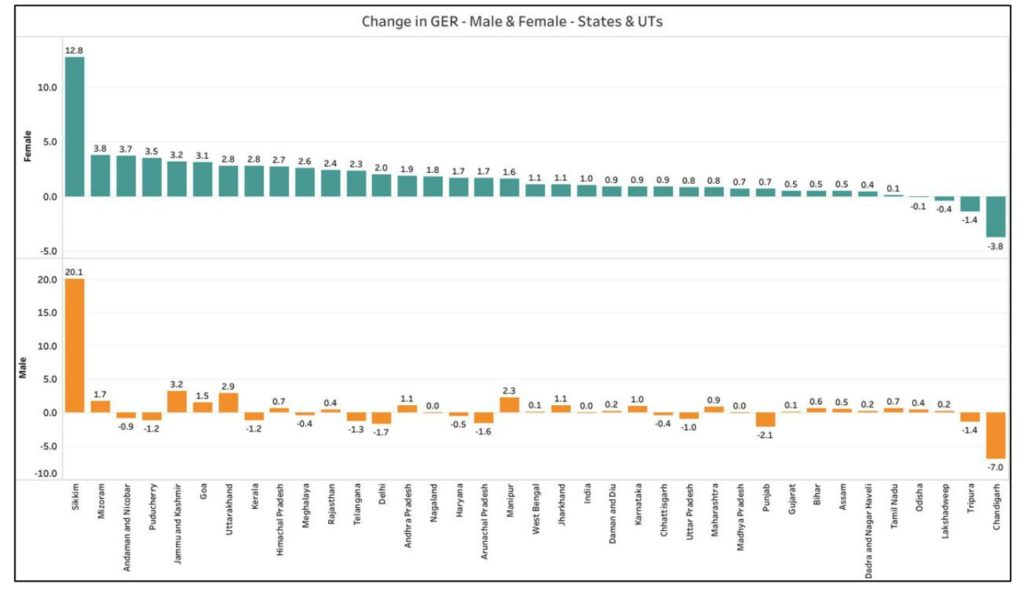[orc]The Gross Enrolment Ratio (GER) of Higher Education has seen a steady increase over the years. In 2018-19, the female GER in higher education was more than the male GER for the first time. However, we are still behind many of the developing & developed nations. Decreasing GER in some of the states is also a cause for concern.
Education is a key factor influencing the growth story & development of a nation. India moved from a nation with 12% literacy rate in 1947 to 74% literacy rate as per 2011 census.
The ASER (Annual Status of Education Report) -2018 states that the enrolment rate in schools between the age 6-14 years is above 96% every year since 2010. Right to Education (RTE) act, 2009 makes access to free and compulsory education a fundamental right for every child between the age of 6-14 years. While there are apprehensions in respect to the quality of school education, the progress made over the years in terms of the reach cannot be discounted.
However, school education is only one part of the education story. Higher education forms the crucial bridge which helps to build on the early education foundation and enable the young population to be productive citizens who can not only earn livelihood but also contribute towards the nation’s growth story. In this story, we look into the enrolment for Higher education in India as per data in the AISHE for 2018-19 (All India Survey on Higher Education).
Increasing trend of Higher Education GER continues
Gross Enrolment Ratio (GER) measures enrolment as percentage of a specific age-group of the population. The Higher Education GER (18-23 age group) in India for the year 2018-19 is 26.3. This is an increase over the previous year and is in line with the increasing trend over the years. In 2014-15, it was 24.3.

While higher education GER in India is on an increasing trend, it stills lags when compared with other countries. The age group for higher (tertiary) education is 18-22 years internationally. When calculated as per the international standard, the higher education GER for India would be 30.6%. While it is higher than Pakistan (9) and Bangladesh (21), it is comparatively less than other countries in Asia – China (51), South Korea (94), Malaysia (45), Indonesia (36), Iran (70) etc. Globally, USA’s higher education GER is 88, UK’s is 60, Germany is at 70 and Canada’s is 69 etc.
Increase in GER among marginalized communities
Apart from an overall increase in Higher Education GER at the all-India level, an upward trend is observed among the marginalized communities in India. The GER among SC community for 2018-19 is 23, while it was only 19.1 in 2014-15. Similarly, among the ST community, the higher education GER increased from 13.7 in 2014-15 to 17.2 in 2018-19.

Bihar, Chhattisgarh, Assam, Jharkhand, West Bengal among states with lowest Higher Education GER
Among the states, Sikkim has shown the highest change with an increase in GER by 16.5 within a year. In 2017-18, it was 37.4 while it increased to 53.9 in 2018-19. Sikkim is also the state with the highest GER in 2018-19.
Among the large states, Tamil Nadu ranks first with a GER of 49 followed by Delhi (46.3), Himachal Pradesh (39.6), Uttarakhand (39.1), Kerala (37) and Telangana (36.2). Other large states with GER higher than the national average include – Andhra Pradesh, Maharashtra, Jammu & Kashmir, Punjab, Haryana and Karnataka.
Among the large states, Bihar has the lowest GER with 13.6, followed by Chhattisgarh and Assam with 18.6 and 18.7 GER respectively. Jharkhand, West Bengal, Gujarat, Madhya Pradesh, Odisha, Rajasthan and Uttar Pradesh are among the states with GER less than all-India average of 26.3 in 2018-19.

Most of the Indian states have shown a positive trend in respect to GER.
Barring a few exceptions, most of the states have shown a positive change in respect to Higher Education GER over the last few years. Punjab, UP and Tripura stand out by being the only 3 states with a negative change in GER in 2018-19 compared to 2017-18.
Punjab’s GER fell by 0.8 (29.5 in 2018-19 from 30.3 in 2017-18). UP’s GER fell by 0.1 (25.8 in 2018-19 compared to 25.9 in 2017-18), while Tripura had a significant fall by 2 (19.2 in 2018-19 from 21.2 in 2018-19).
The UT of Chandigarh recorded the most significant negative change with a fall by 5.8. Higher education GER here was 56.4 in 2017-18 and fell to 50.6 in 2018-19. This fall in GER resulted in Chandigarh being pushed to the second place among Indian States and UTs from its earlier first position in 2017-18.
Sikkim, as noted earlier has the highest positive change with 16.5. Other states with a higher positive change in Higher education GER include – Jammu & Kashmir (3.2), Uttarakhand (2.8), Mizoram (2.8), Goa (2.1), Manipur (1.9) and Himachal Pradesh (1.7).
Although Jharkhand and Rajasthan are among the states with lower GER, they have made a significant improvement over the last over year (in 2018-19 compared to 2017-18) with a positive increase by 1.1 and 1.3 respectively.

Higher Education GER among females overtakes male GER
The All India average for Higher Education GER among males is 26.3 while for females it is 26.4. This is the first time that the GER among females is higher than that of males. There is no change in the GER for males compared to last year. Higher education GER among males was also 26.3 in 2017-18 whereas it was 26 in 2016-17.
On the other hand, GER among females has shown a continuous positive trend. Five years ago i.e., in 2014-15, it was 23.2. However, over the five-year period, female GER is up by 3.2. During the same period, the male GER increased only by 1.
Another significant observation is in respect to the negative growth for male GER in 12 of the 36 states/UTs for the year 2018-19 i.e. 1/3rd of the state/UTs have recorded a negative growth in terms of male GER.
Reflective of its overall growth, Sikkim has the highest growth in GER for both males and females with increase 20.1 and 12.8 respectively.
Among other states, Uttarakhand recorded significant growth of 2.9 and 2.8 GER among male and female population respectively. Jammu & Kashmir, Manipur, Goa, Andhra Pradesh and Mizoram are among the states which have a positive growth in both male and female GER.
States/UTs like Kerala, Telangana, Delhi, Puducherry, Andaman & Nicobar Islands etc. have recorded negative growth of male GER in 2018-19 which is compensated by higher GER among females resulting in overall positive GER compared to 2017-18.
Punjab’s higher negative growth of male GER has offset the positive growth among for female GER.

Need for GER to increase at more rapid rate to gain advantage of the Demographic Dividend
India population is among the youngest in the world i.e. a larger portion of the population is in the productive age. The skillset of this section of population will have a great influence in the development of the country, hence it is imperative that this section of the population needs to have the right skills.
As seen in an earlier metrics, India’s higher education GER lags far behind many of the developed countries. Few of the developing economies in the world also have higher GERs when compared to India.
While the positive trend in the female GER is encouraging, the decreasing trends in male GER in multiple states/UTs is a cause for concern. Fewer Institutions of Higher education within the reach, lack of variety of courses which offer higher employability and better career prospects, fewer resources for research, lack of international recognition for Indian courses etc. are few of the reasons which influence the lower GER in India. Creating opportunities & world class institutions for Higher education has been one of the priorities during the early years of Indian independence, as is evident from the establishment of various IITs, IIMs and other centers of higher learning. However, over the years, both the quality as well as the reach has not kept up with the growing needs.
The Draft National Education Policy (NEP) released earlier this year, takes cognizance of these issues that impact GER. Factly has earlier published an article about the various aspects related to higher education in the draft NEP. Practical implementation of the policies remains the key bottleneck and in view of the current advantage in respect to demographic dividend, the reforms need to go beyond paper.
Featured Image: Higher Education GER


